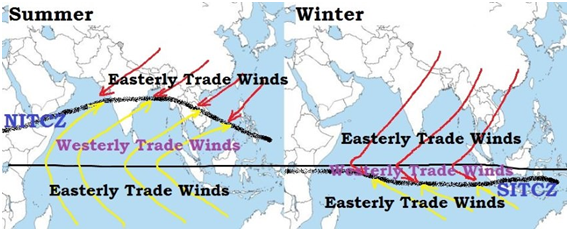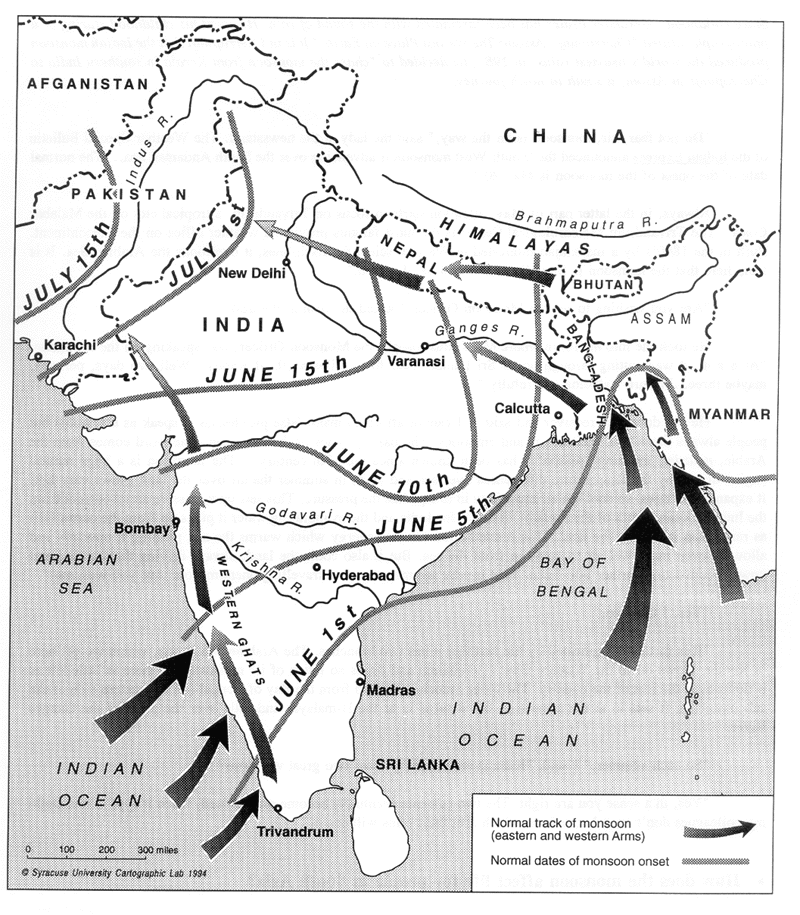Monsoon in India GS: 1 (Geography) "EMPOWER IAS"
In news:
- The northeast, or winter, monsoon has ended on a high, with an overall surplus rainfall being recorded for the season.
More from the news:
- In 2019, the retreat of the southwest (summer) monsoon was delayed by a record margin, while the northeast (winter) monsoon set in on time.
- India Meteorological Department Department (IMD) recognizes October to December as the period for Northeast monsoon.
Indian Monsoons:
- The term monsoon has been derived from the Arabic word mausin or from the Malayan word monsin meaning ‘season’.
- Monsoons are seasonal winds (Rhythmic wind movements)(Periodic Winds) which reverse their direction with the change of season.
- The monsoon is a double system of seasonal winds – They flow from sea to land during the summer and from land to sea during winter.
- Some scholars tend to treat the monsoon winds as land and sea breeze on a large scale.
- Monsoons are peculiar to Indian Subcontinent, South East Asia, parts of Central Western Africa etc..
- They are more pronounced in the Indian Subcontinent compared to any other region.
- Indian Monsoons are Convection cells on a very large scale.
- They are periodic or secondary winds which seasonal reversal in wind direction.
- India receives south-west monsoon winds in summer and north-east monsoon winds in winter.
- South-west monsoons are formed due to intense low pressure system formed over the Tibetan plateau.
- North-east monsoons are associated with high pressure cells over Tibetan and Siberian plateaus.
- South-west monsoons bring intense rainfall to most of the regions in India and north-east monsoons bring rainfall to mainly south-eastern coast of India (Southern coast of Seemandhra and the coast of Tamil Nadu.).
- Countries like India, Indonesia, Bangladesh, Myanmar etc. receive most of the annual rainfall during south-west monsoon season where as South East China, Japan etc., during north-east rainfall season.


Factors affecting monsoon in India-
- The differential heating of the landmass of Asia and the Indian Ocean.
- The existence of the Himalayan ranges and the Tibetan Plateau.
- The occurrence of heavy-light snow over the Tibetan Plateau.
- The existence and circulation of the upper air jet stream in the troposphere.
What is the northeast (winter) monsoon?
- Southwest summer monsoon brings widespread rain across the country.
- For many parts of India, this is the only time they receive rain. These four months bring about 75 per cent of India’s annual rainfall.
- However, for some regions of South India, it is the winter monsoon that is much more important. Though much less heard of, especially in the north of the country, the northeast monsoon is as permanent a feature of the Indian subcontinent’s climate system as the summer monsoon.
- The India Meteorological Department (IMD) recognises October to December as the time for the northeast monsoon.
- During this period, rainfall is experienced over Tamil Nadu, Kerala, and Andhra Pradesh, along with some parts of Telangana and Karnataka.
Why are these two monsoons named thus?
- The northeast monsoon does not have anything to do with India’s Northeast, even though a part of the system does originate from the area above it.
- Rather, it derives its name from the direction in which it travels — from the northeast to the southwest.
- Similarly, the summer monsoon (at least the Arabian Sea branch of it; there is also a branch that swerves in an anticlockwise direction in the Bay of Bengal before entering the Indian landmass and bringing rain to the eastern, northeastern and northern parts of the country) moves in exactly the opposite direction — from the southwest to the northeast. That is why it is called the southwest monsoon.
When does the northeast monsoon set in?
- The southern peninsular region receives rain in the first half of October as well, but that is attributable to the retreating summer monsoon. The summer monsoon season ends on September 30 but the withdrawal does not happen overnight.
- The southward withdrawal takes place over a period of three to four weeks. It usually starts around the second week of September and continues till about the second week of October, bringing rain as it retreats.
- 2019 was unusual in that the withdrawal was completed in just eight days, beginning on October 9.
Where does it rain during the northeast monsoon season?
- The northeast monsoon brings rain to just five of the 36 meteorological divisions in the country — Tamil Nadu (which includes Puducherry), Kerala, Coastal Andhra Pradesh, Rayalaseema and South Interior Karnataka.
- This season contributes only 11 per cent to India’s annual rainfall of 1,187 mm, compared to about 75 per cent in the summer monsoon season (the remaining rain comes in other non-monsoon months).
- Many other parts of the country, like the Gangetic plains and northern states, also receive some rain in November and December but this is not due to the northeast monsoon.
- It is caused mainly by the Western Disturbances, an eastward-moving rain-bearing wind system that originates beyond Afghanistan and Iran, picking up moisture from as far as the Mediterranean Sea, even the Atlantic Ocean.
- In the higher reaches of Jammu and Kashmir, Himachal Pradesh, and Uttarakhand, the precipitation is often in the form of snow. The northeast monsoon is particularly important for Tamil Nadu, which receives almost half its annual rainfall (438 mm of the annual 914.4 mm) during this season.
- The southwest monsoon contributes just 35 per cent to Tamil Nadu’s annual rainfall (the rest comes in other non-monsoon months). Within the state, some districts get up to 60 per cent of their annual rainfall during this time.
- Similarly, Rayalaseema region and Coastal Andhra Pradesh both about 30 per cent, and South Interior Karnataka receives about 20 per cent of its annual rainfall during the northeast monsoon season.
Factors influencing South-West Monsoon Formation:
- The differential heating and cooling of land and water creates a low pressure on the landmass of India while the seas around experience comparatively high pressure.
- The shift of the position of Inter Tropical Convergence Zone (ITCZ) in summer, over the Ganga plain (this is the equatorial trough normally positioned about 5°N of the equator. It is also known as the monsoon-trough during the monsoon season).
- The presence of the high-pressure area, east of Madagascar, approximately at 20°S over the Indian Ocean. The intensity and position of this high-pressure area affect the Indian Monsoon.
- The Tibetan plateau gets intensely heated during summer, which results in strong vertical air currents and the formation of low pressure over the plateau at about 9 km above sea level.
- The movement of the westerly jet stream to the north of the Himalayas and the presence of the tropical easterly jet stream over the Indian peninsula during summer.
- Tropical Easterly Jet (African Easterly Jet).
- Southern Oscillation (SO): Normally when the tropical eastern south Pacific Ocean experiences high pressure, the tropical eastern Indian Ocean experiences low pressure. But in certain years, there is a reversal in the pressure conditions and the eastern Pacific has lower pressure in comparison to the eastern Indian Ocean. This periodic change in pressure conditions is known as the SO.

|
Inter Tropical Convergence Zone
- The Inter Tropical Convergence Zone (ITCZ,) is a broad trough of low pressure in equatorial latitudes. This is where the northeast and the southeast trade winds converge.
- This convergence zone lies more or less parallel to the equator but moves north or south with the apparent movement of the sun.
Factors influencing onset of SW monsoons:
- Intense low-pressure formation over the Tibetan Plateau
- Permanent high pressure cell in the South of the Indian Ocean
- Subtropical jet stream
- African Easterly jet (Tropical easterly jet)
- Inter-Tropical Convergence Zone (ITCZ)
Factors influencing intensity of SW monsoons:
- Strengths of the low pressure over Tibetan plateau and the high pressure over the south Indian Ocean
- Somali Jet
- Somali Current
- Indian Ocean dipole
- Indian Ocean branch of the Walker Cell
|
Significance of Monsoon in India:
- India gets around 70 percent of its annual rainfall during the monsoon season, which also affects the yield of some key Kharif or summer crops like rice, pulses, and oilseeds such as soybeans.
- A delayed monsoon can lead to supply issues and even accelerate food inflation.
- The Monsoon rains in India also replenish reservoirs and groundwater that help in improving irrigation and also boost hydropower production.
- Leads to bumper farm output that keeps food prices under control.
- Below normal monsoon can also lead to drought.
Source)
https://indianexpress.com/article/explained/the-imd-says-india-has-just-finished-a-satisfactory-northeast-monsoon-what-is-this-monsoon-6196789/

